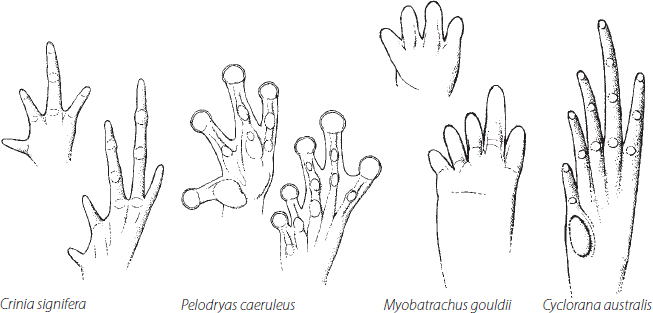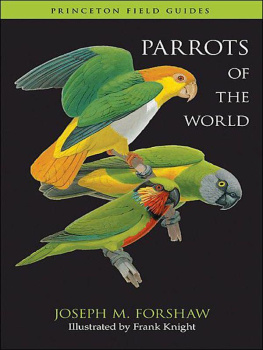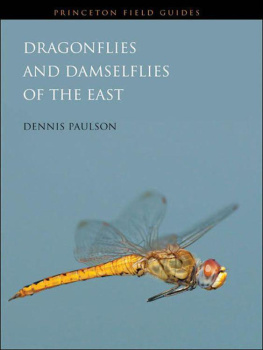Biology

Most frog species lay spawn in water. The embryos hatch into tadpoles and eventually transform into baby frogs. But there are many that differ from this pattern. The most conspicuous are the species which do not have a free-living tadpole. For example, all of the microhylids have embryos that remain within the egg capsules and emerge as tiny frogs.
The most extreme deviants are the two Rheobatrachus species which swallow their fertilised eggs, retain the tadpoles in the stomach and finally give birth through the mouth. Then there is Assa darlingtoni which holds the tadpoles within pouches in the flanks.
In addition to these extremes are other modifications to the life cycle. For example, Litoria longirostris deposits green eggs on vegetation above water into which the emerging tadpoles fall, and Litoria wilcoxii excavates depressions in shallow pools to lay its spawn.
Male or female?
Adult male frogs are more readily recognised than females. Most males have inflatable vocal sacs beneath the lower jaws which communicate with the buccal cavity via paired slits on each side of the tongue. When the frog calls, the vocal sacs are inflated, the skin of the throat extends beyond the edges of the jaws and can be seen from above. To provide camouflage against predators, the throat skin of males is therefore pigmented, whereas the throat skin of females, which is not exposed, is usually white. The male frog skin becomes stretched and forms a fold across the chest termed the pectoral fold.
When a male is grasping a female frog while mating, the pair are said to be in amplexus. There are two positions held by the male frog. In the Hylidae the male clasps the female around the armpits. This is said to be pectoral amplexus. When the male is much smaller than the female, he rides on her back like a jockey upon a horse. In all other families the male grasps the female around the waist in what is termed inguinal amplexus, resembling a rugby tackle.

Vocal sac of the male frog

Diversity of male nuptial pads (right dorsal)
A distinguishing feature of adult males is that they possess black pads (nuptial pads) on the inner surfaces of the first (sometimes first three) fingers. Microscopically they can appear as spines or florets. Occasionally they are enlarged into scattered spikes. These nuptial pads help the male to maintain a hold on the slippery skin of the female. They also release pheromones from glands beneath them. In Litoria nannotis tiny spines are enlarged thorns on the thumb. Large thorns are also characteristic of most Heleioporus species.
The only other sexual differences are that males are usually smaller than females, and in some females eggs can be seen through the body wall at the groin.

Skin glands
Skin glands
Broadly speaking there are three kinds of glands which are found in the skin of frogs: granular, mucous and seromucous.
The granular glands are the most complex and secrete diverse chemical compounds including peptides, alkaloids and catecholamines. Mucous and seromucous glands secrete mucus and mucoid compounds of varying viscosity. Whereas the glandular secretions are scattered throughout the skin, they are commonly aggregated into what are termed macroglands by Duellman and Trueb (1996). The following are those found in Australian frogs named according to their position: parotoid, inguinal, tibial, coccygeal, femoral, supra-mandibular, sub-mental, dorso-lateral.
Nuptial pads on the fingers of the male during the breeding season develop in response to circulating androgen hormones, and should be perceived as skin glands. It has been found in a Rana species that a gland beneath the nuptial pads secretes material called amplexin. Its function in frogs is unknown but a similar gland in salamanders affects the duration of amplexus.
Most of the skin glands contain a cocktail of antibiotics. Some are active against a broad range of bacteria, fungi and viruses. Many have been found in the tree frog Pelodryas caeruleus, including an antiviral agent which prevents the transmission of HIV, and compounds which deter mosquitoes, rodents and birds.
Hand and foot diversity
More than any other part of the body, the form of the hands and feet give an indication of the frogs lifestyle. All that the naturalist needs to do is be able to recognise the adaptations and understand just how they assist a particular lifestyle.
By far the simplest form is represented by Crinia signifera a small, ground-dwelling species with cylindrical digits and poorly developed tubercles beneath them. These features enable the frog to move around on the ground surface without accumulating small fragments of debris.
For a frog living above the ground, the environment lacks this evolutionary constraint but creates the need for new adaptations for it to survive. A good example is the Green Tree Frog, P. caeruleus. Its principal adaptation is the expansion of the end of its fingers and toes to create circular pads. At a microscopic level these pads bear minute square blocks with gaps between them. A soft glue is secreted between the blocks. This glue, combined with surface tension, enables the frog to climb smooth vertical surfaces.
The other extreme, in the form of the hands and feet, is the burrowing form as exhibited by the Turtle Frog, Myobatrachus gouldii. Burrowing requires considerable development of the hands and feet. Most Australian species burrow backwards using the tubercles on the feet. Arenophryne and Myobatrachus burrow headfirst, creating a cornified process on the tip of the snout.

Declining frogs
For several reasons many frog populations are in decline throughout the world. By far the most significant cause is the recent proliferation of a fungus that causes a disease called chytridiomycosis or chytrid for short. The fungal spores invade the skin, and because frogs rely on the skin more than their lungs to take up oxygen and release carbon dioxide, the effect is to impair breathing, which causes the frogs to die. It is clear that the skin is more significant than their lungs for respiration.
Chytridiomycosis is now distributed globally. The active agent Batrachochytrium dendrobatidis was first recognised in 1998. Some herpetology journals devote entire sections in each issue to reporting chytrid disease in more countries, while numerous scientific groups seek information on how the pathogen is dispersed and how its advance in the wild may be halted. Many naturalists are promoting the construction of ponds in gardens to increase breeding sites. Everyone wants to do something, and creating an ideal habitat for frogs is a step in the right direction. The book Attracting Frogs to your Garden by Kevin Casey is a useful guide.
For summaries of information on the chytrid fungus see Berger

















